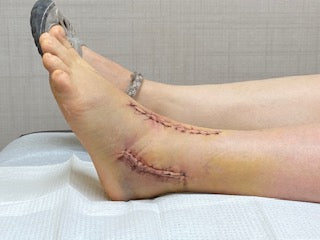25 years of progressive pain in my ankle caused me to have my left ankle replaced in the spring of 2020. Total Ankle Replacement (TAR) has been done since the 1970's, however, TAR outcomes became more positive since the 1990's and is no longer considered an experimental surgical procedure. Actually TAR is considered to be the optimal choice over ankle fusions - especially in a younger client (I am 50 years old) because motion is retained!
My surgery was performed by Dr. Mark Conklin, who practices in Golden, Colorado. He performed the Infinity System (fourth generation) on me with CT guided information regarding my unique anatomy. My ankle required lateral stabilization but did not requiring lengthening of my achilles tendon. This is my journey and so your journey or your client's journey might be different. Always make that you understand the instructions from your surgeon and honor these restrictions and tips.
In preparation for surgery, I shopped for easy preparing food, rearranged my home so that I could use a wheelchair - I chose a wheelchair over a knee scooter because of the ease of carrying items (read FOOD and DRINK without spilling and to decrease stress on my other leg), I also bought a 2 wheeled fixed walker, positioned a folding chair in my shower and made sure I had a large gel ice pack (mine is the lumbar gel pack from Colpack). For me, it worked best to recover and sleep on the couch. I had my leg propped up so that my ankle was above my torso and my operated leg was on the inside of the couch so that it would not fall off of the pillows.
After the surgery, I spent the 1st night in the hospital to have IV antibiotics administered, to have the nerve block wear off and for pain management. On the second day post surgery, I felt more pain because the nerve block wore off. I was placed on a regular course of narcotics and Tylenol and told not to let the pain get ahead of me (a pain rating of 6 was too much pain on a scale of 10 but I should expect to have some pain, a pain rating of 2/10 was good). My ankle was wrapped in an immoveable dressing set in dorsiflexion (DF). I was also told to ice my knee and especially the back of my knee to help with the swelling at my ankle. I was told to wiggle my toes as much as I could and to breath deeply to encourage proper ventilation of my lungs.
After a week I had my first post-op visit. As the bandages came off I saw a well healing ankle with 2 very large incisions. The incision on top of the ankle was due to the TAR and the lateral incision were necessary secondary to lateral ankle instability that needed to corrected.

During this first post-op visit, I was casted in a fiberglass cast - I loved how the cast hugged my ankle - the cast felt protective of my new joint. Once I got home I got busy with wiggling my toes and was rewarded with seeing more and more movement. I decided in these days following the surgery that I was coming back better than ever! During this phase I regularly iced the back of my knee and I flexed, pointed and wiggled my toes and performed non weight bearing Pilates workouts on the floor.

Three weeks post-op, my cast was removed at the doctor's office and I was fitted into a remove able walking cast but with continued orders of no weight bearing on my surgical ankle. I was told that I could do plantarflexion and dorsiflexion and even do some passive range of motion into these directions. I was not to do eversion secondary to the repairs that were necessary on the outside of my ankle (lateral incisions) but in a week's time I could add active inversion of the ankle and at this time I could also soak the ankle - bath time in another week's time! During this time I began to work on the flexibility of my toes. This is because the tendons of the toes are long and cross the ankle joint. The toes can be stretched with and without moving the ankle joint. With stretching my toes into flexion and extension, I could feel the tightness in the front of my ankle - pulling on the scarring that is the natural occurrence of the healing process. I also felt tightness in the posterior medial and lateral aspect of the muscles of my lower cast with stretches. Here is a video of how I stretched my toe tendons. If you had your achilles tendon lengthened, this may not be appropriate - always check with your doctor .
At this time I also began scar massage. I made sure I washed my hands throughly and sprayed the area with a 60% mixture of rubbing alcohol. I worked the scar directly and to the sides of it - encouraging mobility. I avoided any areas that were draining or looked as if it was just barely closed. I rubbed Neosporin into the scar. I also massaged the ankle joint with CBD cream ( I used By George 1000mg CBD cream) and massaged the rest of my foot and calf with regular lotion. After this work, I iced my ankle for 20-30 minutes. I did these sessions 2-3 times a day.
Please check back for phase two - for more in depth scar massage and non weight bearing exercises.

